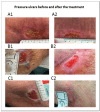Chitosan Gel to Treat Pressure Ulcers: A Clinical Pilot Study
- PMID: 29342089
- PMCID: PMC5874828
- DOI: 10.3390/pharmaceutics10010015
Chitosan Gel to Treat Pressure Ulcers: A Clinical Pilot Study
Abstract
Chitosan is biopolymer with promising properties in wound healing. Chronic wounds represent a significant burden to both the patient and the medical system. Among chronic wounds, pressure ulcers are one of the most common types of complex wound. The efficacy and the tolerability of chitosan gel formulation, prepared into the hospital pharmacy, in the treatment of pressure ulcers of moderate severity were evaluated. The endpoint of this phase II study was the reduction of the area of the lesion by at least 20% after four weeks of treatment. Thus, 20 adult volunteers with pressure ulcers within predetermined parameters were involved in a 30 days study. Dressing change was performed twice a week at outpatient clinic upon chronic wounds management. In the 90% of patients involved in the study, the treatment was effective, with a reduction of the area of the lesion and wound healing progress. The study demonstrated the efficacy of the gel formulation for treatment of pressure ulcers, also providing a strong reduction of patient management costs.
Keywords: chitosan; chronic wounds; clinical study; gel; pressure ulcers; wound healing.
Conflict of interest statement
The authors declare no conflict of interest.
Figures
References
LinkOut - more resources
Full Text Sources
Other Literature Sources



